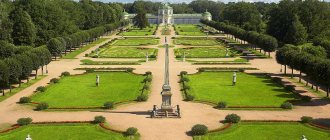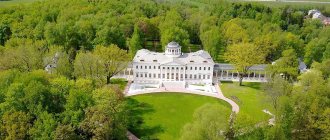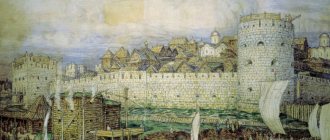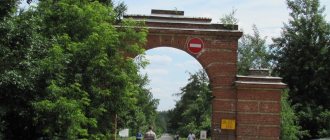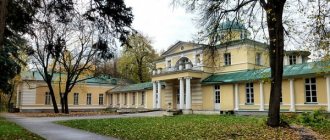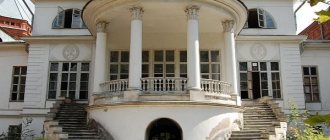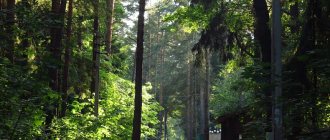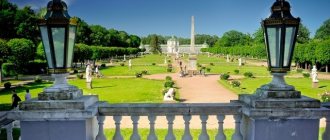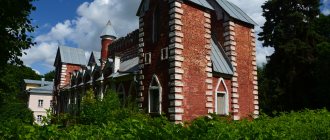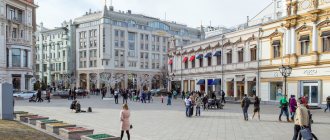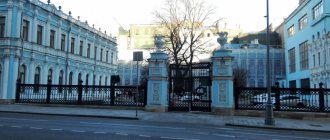In the Solnechnogorsk district, near Skhodnya, there is an ancient Serednikovo (Mtsyri-Spasskoe) estate located near Moscow. It is interesting to us both as a park and estate ensemble of the late 18th - early 19th centuries, and as a memorable place associated with the poet M.Yu. Lermontov and statesman P.A. Stolypin
View of the main house of the Serednikovo estate with outbuildings
The first mentions of the owners of these lands date back to the beginning of the 16th century. Since then, Serednikovo has had many owners, until in 1825 the estate was acquired by Major General Dmitry Alekseevich Stolypin, the brother of M. Yu. Lermontov’s grandmother, Elizaveta Alekseevna Arsenyeva. It was thanks to these family connections that the poet came here with his grandmother during the summer holidays of 1829-1832. The development of the great poet's talent took place here. In Serednikovo, the young Lermontov wrote seven poems, two dramas, and about a hundred poems.
In 1855, the poet’s cousin, A.D., became the owner of Serednikovo. Stolypin, father of Pyotr Arkadyevich Stolypin. The childhood of the future statesman, Prime Minister of the Russian Empire, passed in this estate. Later, these properties were sold to the merchant of the 1st guild Ivan Firsanov, and then passed to his daughter, Vera Ivanovna. Being a well-educated lover and connoisseur of art, she turned the estate into one of the centers of cultural life in the Moscow region. Fyodor Chaliapin, composers Sergei Rachmaninov and Julius Konyus, artists Valentin Serov and Konstantin Yuon visited her here.
View of the pond of the Serednikovo estate
It was at the request of V.I. Firsanova that a stop was opened next to the estate, called Firsanovka. To this day, this platform of the Oktyabrskaya Railway is called Firsanovskaya. After the revolution, the estate was nationalized. In 1919, V.I. rested here. Lenin, the option of using the estate as a residence was considered. Soon a health resort for members of the All-Russian Central Executive Committee was opened on the former estate, and then a sanatorium for the mentally ill “Mtsyri”. In the fall of 1941, the Moscow defense line passed near the estate; traces of earthen fortifications are still preserved in the park. A German tank was hit at the gates of the estate, but the Germans did not break into its territory
After the war, the estate housed an anti-tuberculosis sanatorium. In the early 1990s. The Serednikovo estate was in a dilapidated state; no funds were received for restoration. In 1991, the great-grandnephew of the great poet and his full namesake, Mikhail Yuryevich Lermontov, together with his relatives, founded a public organization - the Lermontov Heritage Association, which united more than 200 representatives of the ancient Kostroma family of Lermontovs from Russia and the USA, France, Brazil, Switzerland, Bosnia and Herzegovina, as well as the Scottish LermOnts
In the park of the Serednikovo estate
In 1995, the Lermontov Heritage Association leased the Serednikovo Estate, a federal cultural heritage site in disrepair, for 49 years to revive it as a cultural and memorial complex. At the expense of the President of the Association, large-scale work was carried out to restore the estate complex, recreate and improve the park area. Nowadays, on the basis of the architectural monument “Serednikovo Estate”, a multifunctional research, restoration, cultural, educational and museum center has been created, cultural and educational tourism is developing, a Sunday school is operating, exhibitions and festivals of various subjects are held.
At the gates of the main house of the Serednikovo estate
The estate complex is also used for organizing recreation and entertainment events, holding photo sessions and various types of celebrations - from intimate ones (such as romantic dates) to large-scale ones (corporate parties, balls, etc.). The Serednikovo estate has served and continues to serve as a location for the filming of numerous films and TV series. “Poor Nastya”, “Closed School”, “Notes of the Forwarder of the Secret Chancellery”, “Servant of the Sovereigns” and many others were filmed here. For example, in the film “Admiral” the estate depicts the emperor’s headquarters in Mogilev:
Serednikovo estate in the film “Admiral”
The films mainly use the surroundings of the estate and the surrounding park with ponds, but sometimes filming is carried out in the interiors of the main house, as for example in the 2013 film “Love for Love”
Serednikovo estate in the film “Love for Love”
The next day after the trip to the estate, I myself saw her again on television in some new feature film.
Serednikovo estate in the Moscow region
Website: serednikovo.su Address: Moscow region, Solnechnogorsk urban district, pos. sanatorium Mtsyri. Opening hours: daily from 9.00 to 22.00. Entrance fee to the park: 100 rubles, pensioners - 30 rubles. Children under 14 years of age and disabled people are free. Cost of visiting the State House (only as part of a scheduled excursion group): 300 rubles, for schoolchildren, students and pensioners - 250 rubles.
The Serednikovo estate in the Moscow region in different years of its existence belonged to the Vsevolozhsky nobles, and then to the Stolypins. It is an example of a classic Russian estate of the late classicism era and one of the most popular Lermontov corners in our country.
After the revolution, the Mtsyri sanatorium was opened in the estate. By the end of the 20th century, the estate was abandoned and neglected, restored in the 1990s - 2000s.
In the field of medicine
The first and last historical figure to visit the estate during the Soviet period was the leader of the revolutionary movement, Vladimir Ilyich Lenin. He vacationed on the estate in the summer of 1919. 6 years after his departure, the first medical institution in its history was established on the basis of the estate. In 1925, a sanatorium for nervous patients opened its doors. It existed until the very beginning of the Great Patriotic War.
The first residents of the estate during the war years were children. The pioneers were “lucky” - in July 1941 they were evacuated from the Artek camp near Moscow, and at the end of the summer the guys were again taken away from the fighting - near Stalingrad. It is not known for certain what the fate of the poor children was, but what was done was necessary. Already in the fall, the Serednikovo estate, located just 25 kilometers from the capital, became one of the lines of defense. In the garden of the estate there are still traces of the fortifications erected there, and the bell tower of the Temple in the name of Metropolitan Alexy was dismantled so as not to be a landmark for Nazi artillery and aviation.
All these preparations helped - the Germans never occupied Serednikovo; for a long time there was an enemy tank in front of the entrance to the estate, knocked out by the defending Red Army soldiers. The buildings of the estate themselves housed the second medical institution in its history - a military hospital. When the front moved and the course of the Great Patriotic War was turned, partisans began to be trained on the territory of the estate for their further dispatch to Belarus, which was still occupied by the Germans. When the need for the headquarters of the partisan movement of this republic disappeared, the Serednikovo estate disappeared from history for a short time. Only a year after the end of the war they remembered her again. The third medical institution began to function on the basis of the former estate - the Mtsyri anti-tuberculosis sanatorium opened. It existed until the collapse of the Soviet Union; after its closure, the already dilapidated buildings of the estate were abandoned for several years. Another wasteland began to form on the territory of the once beautiful family nest of the Stolypins.
How to get there from Moscow
By train : from Leningradsky railway station in Moscow to Firsanovka railway station, travel time is 40–50 minutes. Then take bus number 40 to the final stop “Sanatorium Mtsyri”.
By bus from Zelenograd: by bus No. 7 from Zelenograd to Firsanovka station, then by bus No. 40 to the Mtsyri sanatorium.
By car: along Leningradskoye Highway, then turn off at the village of “Chernaya Gryad” towards Firsanovka.
Interesting facts about the Serednikovo estate
- Initially, the area where the estate is located was called Goretov Stan, since the Goretovka River flows nearby. However, in the center of Stan lay the Serednyaya wasteland, so the settlement on it was renamed Srednikovo, and then - modern Serednikovo.
- In the Oval Hall of the main house of the estate complex you can see the wood trim. However, in reality there is a metal structure under the ceiling, which is painted so that it appears to be made of wood.
- There are chandeliers in the rooms that are very similar to the old ones. However, the last time candles burned in these halls was back in the 18th-19th centuries. Today's lamps are made by modern craftsmen according to the drawings of former times.
- In the foyer of the main house of the estate there remains a fragment of antique floor tiles. It differs significantly from modern ones in both manufacturing technology and design. To keep it safe and sound, tourists are asked to wear shoe covers.
- Russian films were filmed in the park area and in the rooms of the Serednikovo estate: “The Black Monk” (1988), “The Servant of the Sovereign” (2005), “Gloss” (2007), “Admiral” (2008), “Notes of the Forwarder of the Secret Chancellery” (2009 -2010), “Love for Love” (2012), “House on the Edge of the Forest” (2016), “Sect” (2019), as well as the series: “Poor Nastya” (2003-2004), “Closed School” (2011 -2012).
- The distance from the Serednikovo estate to the city of Zelenograd is 11 km, to Khimki - 16 km, to the city of Istra - 40 km, to Zvenigorod - 74 km.
History of creation
The main entrance to the estate
At the beginning of the 16th century, the land plot where the Serednikovo estate would later appear belonged to the ancient Russian noble family of the Dobrynskys. However, in 1525, the Moscow boyar and commander Ivan Dobrynsky decided to donate Serednikovo to the Chudov Monastery, a monastery created by St. Alexy. Almost a hundred years after these events, the land was the patrimony of the holy wasteland.
In 1623, the territory of the modern estate was transferred to Prince Nikita Cherkassky, whose family owned it for about 150 years. His grandson managed to obtain permission to build a stone church in the name of Metropolitan Alexy. Further construction of buildings took place in an accelerated manner, thanks to which at the beginning of the 18th century a good-quality church, a main house, cattle and horse yards, as well as a building for clerks already stood in Serednikovo.
Devil's Bridge
However, the real history of the estate begins only in 1775 , when the estate was transferred to Senator Vsevolod Vsevolzhsky. He decided to build a state estate on the territory. Thanks to him, a main house with outbuildings, administrative and utility buildings, greenhouses, greenhouses, orchards, and workshops appeared in Serednikovo. An English landscape park was laid out with three artificially created ponds and three stone bridges across the ravine. Now only one pond has survived - the Lower Barsky Pond.
Story
The lands on which the estate was later built have been known since the beginning of the 16th century. They passed from one owner to another more than once; at one time they even belonged to the Miracle Monastery of the Moscow Kremlin.
The first manor buildings appeared here at the beginning of the 17th century. Then Serednikov’s owner was Prince Ivan Mikhailovich Egupov-Cherkassky. He built a stone church, a manor house, a clerk's yard, a stable and a barnyard.
Main manor house with belvedere
In 1775, Serednikovo was bought by an actual state councilor, senator Vsevolod Alekseevich Vsevolozhsky. It was under him that the architectural ensemble of the estate was basically created, many elements of which we see now. And he did not skimp: he built a state house with a belvedere and four wings, and laid out a park with a cascade of ponds. He furnished the estate with luxurious furniture and works of art, and kept horses of expensive breeds in the stables.
In 1796 Vsevolozhsky died. He had no children; his only direct heir was his brother Sergei. But it was not he who took possession of the estate, but the nephew of the deceased, Vsevolod Andreevich. Taking advantage of the fact that the legal heir was left out of work, he removed some of the furniture and utensils, horses and livestock from the estate and sold it. By the time Sergei took over ownership, the estate was almost ruined. But the most serious, irreparable loss was the documents, including a detailed plan of the estate complex and papers on the construction of the house - they were destroyed by the false owner.
Colonnaded wings located to the left of the main house
From 1811 to 1825 the estate belonged to different owners. One bought it and resold it to another after a few years. But in 1825, everything changed: the estate was acquired by Major General Dmitry Alekseevich Stolypin, the brother of Lermontov’s grandmother Elizaveta Arsenyeva. For three years in a row, from 1829 to 1831, Elizaveta Alekseevna brought young Misha here for the summer months. Here the poet wrote about a hundred poems, two dramas and seven poems, including the famous “Demon”.
The Stolypin family owned Serednikov until 1869. Then the estate was acquired by the merchant Ivan Firsanov. To offset the cost of the purchase, he gave away the forest surrounding the estate for felling and sold off some of the antiques stored in the house.
The last owner of the estate was Firsanov’s daughter, Vera. Well educated, knew several languages, had excellent artistic taste and was known as a connoisseur of art, she turned Serednikovo into the center of cultural life in the Moscow region. Fyodor Chaliapin, Sergei Rachmaninov, Valentin Serov and other artists came to visit her at the estate. Vera Ivanovna was a famous philanthropist. With her money and at her request, a station was built not far from Serednikov, which is still called Firsanovskaya, and a school was built in the neighboring village of Ligachevo. The Serednikovo estate belonged to Vera Ivanovna until 1917.
Outbuildings located on the right
After the revolution, the estate was nationalized. In 1925, a sanatorium for nervous patients was opened here, which was called “Mtsyri”. He worked until 1941. During the war, there was a field hospital in the main house, and in 1946, an anti-tuberculosis sanatorium was located on the territory of the estate, which retained the name of the former health resort here - “Mtsyri”. He worked until the 1960s, and after that the estate was abandoned and gradually fell into disrepair.
Serednikovo received a second life when, in 1991, the great-grandnephew and full namesake of the poet Mikhail Yuryevich Lermontov, together with relatives and descendants of the poet, founded the Lermontov Heritage Association. The organization received a long-term lease on the estate and restoration work began. Although restoration is still ongoing, Serednikovo is open to guests. Excursions, creative evenings, festivals and other events are held here.
Lermontov
Half a century later, the Serednikovo estate in the Moscow region was sold to Major General Dmitry Stolypin, the great-uncle of Mikhail Yuryevich Lermontov. The poet himself visited here in the summer in 1829-1832 with his grandmother, at the age of 14-17, while studying in Moscow.
It is known that it was here that young Misha first experienced feelings of love, which influenced all his future work. It was also here that he wrote his first lines of poetry, read a lot and did translations.
Study (Stolypin's room)
In 1855, the estate passed into the hands of Arkady Stolypin, the father of the future prominent Russian politician and reformer. His son, Pyotr Arkadyevich Stolypin, spent his childhood here in the 1860s.
A helping hand through the centuries and a new life
Mikhail Yuryevich Lermontov saved Serednikovo from complete destruction. And in the literal sense. The organization he headed in 1992 leased the estate for 49 years. From that time on, the estate began to be called “Lermontov’s estate - Serednikovo”. Mikhail Yuryevich, in question, is alive and well today. He is the full namesake and distant relative of the great poet. The organization he heads is called “Lermontov Heritage”. The 4 summers the writer spent with the Stolypins as a youth saved their family nest from complete destruction. For the next ten years, the tenant was engaged in the restoration of the estate. Today, the entire park and estate ensemble appears to visitors in its original form. The central house and its 4 two-story wings have been restored, and it is connected to them by colonnades. There is a former barnyard and a pseudo-Gothic stable on the site. The park with a pond and bridges (the most beautiful of them is the four-arched “Devil’s”), as well as the central alley and its staircase, have been restored to their proper form. All this is open to visitors. In one of the most famous Lermontov places, as Serednikovo is called by its landlords, you can take a walk and go on excursions to the main building and the temple. The church, built by the Circassian princes, still stands today, although it has changed somewhat since its construction. During the restoration in 1860, a three-tier bell tower was added to it.
Firsanova
In 1869, the estate was again transferred to new hands. This time it was bought by the Moscow merchant Ivan Firsanov, who cut down the forest located next to the estate and sold the ancient furnishings of the estate, earning 120 thousand rubles.
Pink (Lermontov) room
But his heir, Vera Firsanova, did quite a lot for the estate she loved. She was sensitive to the fact that Mikhail Lermontov once lived in the house. In 1900, Firsanova commissioned the famous sculptor Vera Golubkina to create a bronze bust of Lermontov, which can now be seen in the Lermontov room of the State House. In 1914, on the occasion of the centenary of the poet’s birth, an obelisk dedicated to Lermontov was erected in the park next to the Main House. In the Oval Hall, a lampshade was decorated on the theme of the poem “The Demon” by Russian artist Viktor Stember.
Plafond “Demon and Angel Carrying away Tamara’s Soul”
Vera Firsanova, using her influence, managed to ensure that the Nikolaev Railway train made a stop near her estate, and a stop called Firsanovka was opened. The station building was built with Firsanova's money. She also built a hospital, a school and a bridge across the river near the estate. Artists Konstantin Yuon and Valentin Serov, composers Julius Konyus and Sergei Rachmaninov, and singer Fyodor Chaliapin came to Serednikovo to visit Firsanova.
After the revolution, Firsanova was given a communal room in an apartment on Arbat that previously belonged to her. Thanks to Chaliapin, she managed to go abroad to Paris in 1928, where she died in 1934.
Young poet and great reformer
Not many people know, but the Stolypins were related to the Lermontovs. Therefore, the then unknown 15-year-old Misha came to Ekaterina Arkadyevna with her grandmother to stay and relax. He spent four summers on the estate, from 1829 to 1832, and during this time he managed to experience his first love and write his first poems about it. Several vacations spent by Mikhail Yuryevich Lermontov at the estate would later play a very important role in the history of Serednikovo, although in our time, but more on that a little later.
The last of the Stolypin family who owned an estate was Arkady Dmitrievich, the father, again, of the last reformer of the Russian Empire. In this man’s life, as far as Serednikovo is concerned, the number 7 strangely prevails. Judge for yourself: when Arkasha turned 7 years old, he meets his nephew - 15-year-old Misha Lermontov comes to the estate for the first time. Arkady Dmitrievich became the owner 7 years before the birth of his son Petya. He spends the first 7 years of his life in Serednikovo.
The father of Pyotr Arkadyevich Stolypin, the author of the agrarian reform, sold the family nest in 1869.
Current state
Towards the end of the 20th century, the Serednikovo estate in the Moscow region was abandoned. But in 1992, it was leased to the Lermontov Heritage Association, which is headed by the poet’s relative, Mikhail Lermontov, who is his full namesake. In recent years, repair work has been carried out to partially restore the estate. Also in Serednikovo there is now a Sunday school, and various exhibitions are periodically organized.
In addition, those who wish have the opportunity to rent an architectural complex for celebrations, weddings and other events. Many people come to the plot just to take a walk, imbued with the spirit of the old house, and to honor the memory of the great Russian poet.
Another desolation and secular-intellectual life
The merchant of the first guild, Firsanov, purchased the estate from the Stolypins. Pre-revolutionary businessman Ivan Grigorievich only wanted to make money on the purchased land. By cutting down the forests around the estate, he recouped the 75 thousand rubles spent on the purchase, and by selling antique furniture and decorations, he earned another 45 thousand. The Serednikovo estate was once again written into the annals of history by his daughter, who decided to live on the land actually plundered by the priest.
Vera Ivanovna Firsanova was an educated person and a great connoisseur of art; cultural figures from Russia at the end of the 19th century often visited her. Fyodor Chaliapin, Sergei Rachmaninov, Julius Konyus, Valentin Serov and Konstantin Yuon - this is not a complete list of names of artists who visited Firsanova and the estate. By the way, the latter, one of the organizers of the Union of Russian Artists, liked the estate so much that he bought part of the land from Vera Ivanovna and, having settled, organized his studio here.
Konstantin Fedorovich Yuon was seduced by the local views, however, as subsequent events showed, the future member of the USSR Academy of Arts was attracted not only by the beauty of nature. The Soviet artist married right there, to a local native, Nikitina. The last private owner of the estate was proud that the estate was connected with Mikhail Lermontov and emphasized this connection in every possible way. So, in 1890 she ordered a painting from Victor Stember. The artist took up the plafond of the Oval Hall of the master’s house, which he decorated based on “The Demon” by Mikhail Yuryevich. On the 100th anniversary of the birth of the great Russian poet, in the courtyard of the estate, by order of Vera Ivanovna, an obelisk was erected in honor of this significant event. Firsanova also ordered a bust of the poet from the then famous sculptor Anna Semyonovna Golubkina. The work of art, as soon as the sculpture was cast, was delivered from Paris to Serednikovo. However, the dawn of the estate did not last long. The revolution deprived Firsanova of her rights to the estate - it was nationalized.
Sights of the Serednikovo estate
The entire estate complex occupies 99 hectares in the northern Moscow region. It includes several parts: the main house and four wings, connected by galleries with columns, forming a single complex. There is a belvedere (turret) on the roof of the Main House and each wing. Its windows face all directions of the world to admire the surroundings.
On the territory of the estate there are also the ancient church of St. Alexis, an impressive landscape park with three artificial ponds, stone bridges, and other outbuildings, including a greenhouse, a horse yard, a carriage house, an arena and a barnyard.
Outbuildings and galleries
The owners did not live in the main house. It was used for receiving guests, holding concerts and social events. Both hosts and guests were accommodated in outbuildings adjacent to the estate.
Four two-story wings are located to the left and right of the main house. They are connected to it and to each other by galleries with a colonnade . One wing was residential, the second was for guests, the third had a kitchen, and the fourth was reserved for servants. Initially, the gallery passages between them were covered. It was convenient: you could move from one building to another without going outside. And the food that was carried from the kitchen to the master’s table did not cool down. Vera Firsanova made the passages open, with columns.
Main house
The mansion with a belvedere is a luxurious example of Russian classicism. It is fenced, and you can only get inside with guided tours, which take place several times a day. The two-story house is distinguished by smooth and strict lines and restrained architectural decor. On both sides of the house there are wings connected by columns. The top of the mansion is crowned with a figurine of a duck, symbolizing the hearth.
The peculiarity of the main house is that it has no living rooms, it was used only for receiving guests. At night, the owners and visitors of the estate stayed in the outbuildings. Vera Firsanova became the only housewife who changed this tradition; she lived in the Main Front House itself.
Lobby
During the excursion, in an hour and a half, tourists have time to see a ceiling fresco based on the plot of the poem “The Demon” and authentic Moorish stained glass windows. You can also visit numerous halls furnished in the fashion of the 18th-19th centuries: the lobby, the hallway, the Lermontov room, the billiard room, the Oak Hall, Stolypin’s office and room, the Oval living room.
In addition, during a tour of the house, guests of the Serednikovo estate are told about Mikhail Yuryevich Lermontov’s stay in this estate, as well as about the poet’s first love and the development of his talent, and after that, tourists can proceed to the obelisk of Lermontov, which is located in the garden.
Outbuildings
The greatest interest of tourists is usually the cattle and horse yards, the riding arena, as well as the Gothic carriage house with its “prickly” interior design. Purebred Arabian horses, which were bred in Serednikovo, were valued not only among nobles, but even at the sovereign's court.
The greenhouse located at a distance is also worthy of attention, in which the Firsanov merchants cultivated all kinds of exotic fruits year-round. These fruits were then successfully sold in the capital.
Church of St. Alexis
The first stone church appeared on this territory at the end of the 17th century, but already at the beginning of the 19th century it was rebuilt in the style of Russian classicism. The latest building of the temple is considered to be a bell tower of three tiers, erected in the 60s of the 19th century. And most importantly, the relic icons are considered the highlight of the church’s decoration.
Park ensemble
The manor park begins immediately behind the central gate and security post. It was planted with linden trees, oaks and larches by Vera Ivanovna. The first building you come across on the way to the estate is a round arena from the 19th century.
Manege
A ceremonial linden alley leads to the estate complex . The buildings to the right of it are a horse yard and a carriage house . On the left is the barnyard . Cows and sheep of expensive breeds were kept there. Fruits and vegetables were grown greenhouses nearby
To the north of the main house, on the opposite side from the entrance, a large staircase leads to a pond. Going down it, on the right you will see a stone obelisk . It was installed by Firsanova in 1914 in memory of Mikhail Yuryevich, on the 100th anniversary of the poet’s birth.
The pond in the park is artificial, but created on the basis of the natural landscape of the territory - deep ravines and the bed of the Goretovka River, which flows here. Next to the pond there is a stone bridge - one of three in the park. It is called Nizhny , or Bridge of Love. Two more bridges are located in another part of the park. They are called Red and Devil . The last one is the largest and most beautiful.
The front alley leading to the main house
At the opposite end of the park from the entrance there is a small church of St. Alexius . This is the very first manor building; it appeared here at the end of the 17th century. The temple never closed; services continued both in the post-revolutionary period and during the war.
Landscape park
The impressively sized landscape park originates immediately at the rear exit of the front house of the estate complex. There is a wide white stone staircase to descend to the ancient cascading ponds. There you can also see the famous three strong bridges made of stone. According to legend, on the three-span “Devil’s” bridge, which stands on ellipsoidal arches, you can make a wish.
In the landscape park you can also take a walk in the shade of spreading trees and go down to the banks of the local Goretovka River.
Cinema City "Pilgrim Porto"
Entry cost: 200 rubles, disabled people and children under 3 years old - free. Amateur photography with a camera - 1000 rubles.
The Serednikovo estate in the Moscow region is often used by film directors and producers as a filming location. The number of films and TV series filmed on the lands of the architectural complex and landscape park is already about ten.
Upon completion of filming, the scenery is not destroyed: an entire film city has been created on its basis, open to everyone.
At the moment, “Pilgrim Porto” already contains the scenery of English villages and villages of the 17th century, fortress walls, an ancient pier with a frigate, a medieval tavern, hotel rooms and even a prison.
